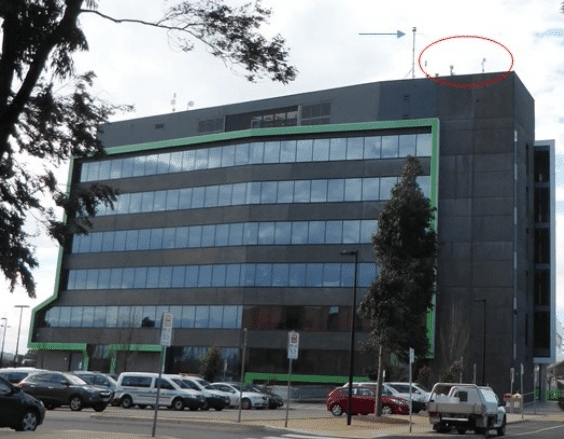Latest News & Trending Topics
ATSB Finds No Safety Management Principles in Department Decision-Making
A recent ATSB investigation highlights the importance of safety management principles in assessing applications for buildings that may affect air safety.
In May 2018, the Australian Transport Safety Bureau (ATSB) released its Final Report entitled Building approval process for structures in the vicinity of Australian airports. The Report found that the requirements contained in the Airports Act 1996 (Cth), the prime legislation that governs the planning framework for federally-leased airports, may not provide the proper safety management approach that it was intended to provide.
Application giving rise to report
In October 2009, Hume City Council applied to operators at Essendon Airport to build a radio mast on top of the council office building in Broadmeadows, Victoria. Pictured below shows existing antennas (circled in red) and the proposed radio mast (indicated by a blue arrow).
Source: ATSB Report AI-2013-102 page 1 © Commonwealth of Australia 2018
The application identified that the building and masts had not been approved under the relevant regulations, the Airports (Protection of Airspace) Regulations 1996 (Cth).
These regulations required that any proposed construction breaching protected airspace around certain airports be approved by the Secretary of the Department of Infrastructure and Transport (now known as the Department of Infrastructure, Regional Development and Cities).
This particular application was for a mast that intruded into protected airspace, which included airspace defined by the airport’s ‘obstacle limitation surfaces’ (OLS). The Secretary was required to approve this proposal unless it would have an unacceptable effect on the safety of existing or future air transport operations.
The initial response from the Civil Aviation Safety Authority (CASA) was that the building and masts were hazardous to aircraft and therefore should be marked and lit. The proposed radio was simply a further hazard.
The Department considered this advice to be inadequate and instructed CASA to find that either the application for the mast had an unacceptable effect on safety or it did not. CASA ultimately found in the negative but advised on lighting and marking requirements.
ATSB finds no application of safety management principles
The ATSB carried out an investigation four years later in 2013 into the procedures of these decision-making processes. This was done as a response to a REPCON report received in September 2012 expressing concerns a proper safety case was not conducted on the proposal. The ATSB’s Final Report concluded that whilst the procedure was compliant with the Airports Act 1996 and the Regulations, it “did not require the application of risk management principles to the Department’s consideration”. This was highlighted as a safety issue.
The Department instead adopted a prescriptive rather than a safety management-based approach in its decision-making. This meant that the process required an answer to the question of whether the obstacle was either acceptable or unacceptable.
This was a simple binary approach and did not involve the application of safety management principles. The Department did not even have the necessary expertise or resources to make such an assessment. Because of this, they relied on CASA’s advice. The Department weighted CASA’s opinion above all others and there was nothing to suggest CASA was provided with all relevant safety information.
Such an approach was contrary to the risk-based approach advocated by the International Civil Aviation Organisation (ICAO). ICAO had required member States in 2006 to establish a State Safety Programme, which the Department adopted in 2011. Australia’s program identified certain laws relevant to the oversight of safety in aviation. That legislation included the Civil Aviation Act 1988 and several other regulations. Interestingly, the Airports Act 1996 and its Regulations were not included.
What has been done
The Department has now advised that it will confer with key stakeholders in the process in relation to risk management practices. It released a Public Consultation Paper in December 2016 entitled Modernising Airspace Protection. It has also initiated public consultation. Avlaw Aviation Consulting is pleased to have contributed to this consultation.
This case demonstrates the importance of safety management approaches within our government institutions. ICAO considers the safety management approach ‘best practice’ and has been adopted by numerous countries around the world. If you need any advice on safety for a building application, do not hesitate to consult our aviation and construction experts at Avlaw Aviation Consulting.
